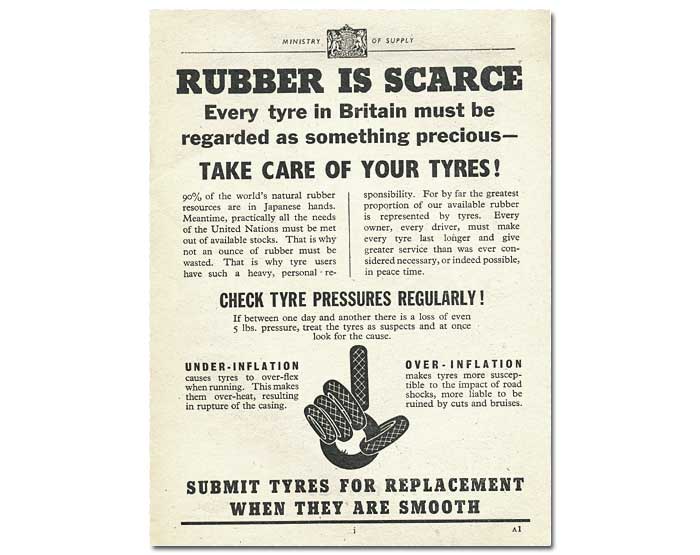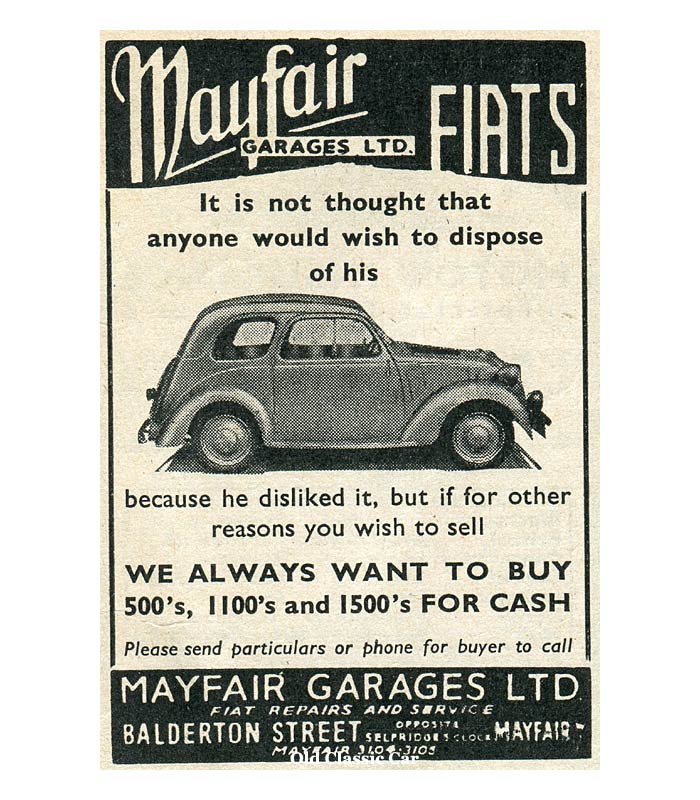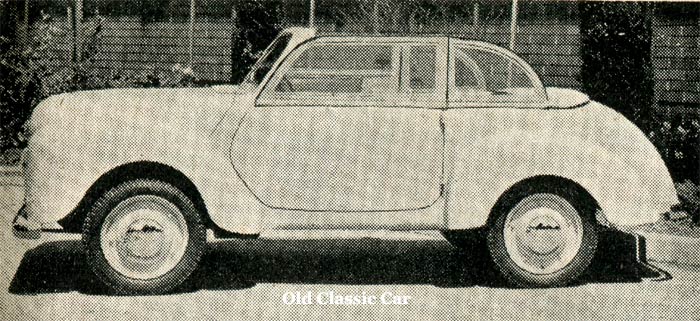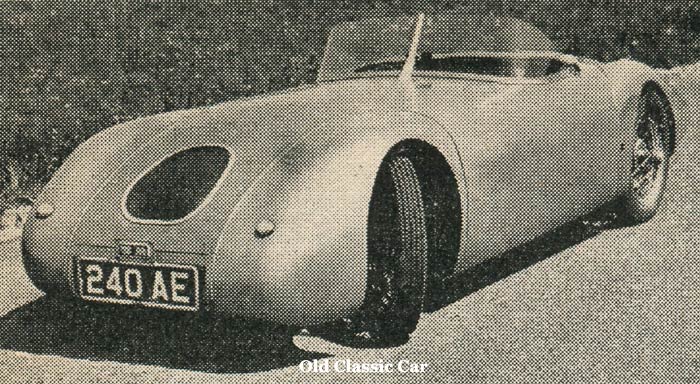The Light Car.
This magazine is perhaps most often associated now with motoring in the 1920s and 1930s, when it was still known as The Light Car & Cyclecar, rather than during the dark years of austerity motoring endured in, and after, WW2. Prior to the war, the magazine was a full-sized publication, and sold on a weekly basis. Pages would overflow with advertisements for all the latest makes and models, motoring accessories, information on day trips to the coast, and a wealth of information on the latest design trends.
|
|
However by April 1943, the date of this copy, things had changed significantly. No longer was The Light Car a weekly magazine. Enthusiasts yearning to read about motoring during the war had to make do with a monthly fix instead. Gone too the full-sized layout, replaced by this smaller replacement, approximately A5 in dimensions.
|

|
Motor manufacturers' advertisements during WW2.
At least the publishers managed to produce a magazine with colour to the outer cover still. This month's issue incorporated an advertisement by The Austin Motor Company Ltd on its cover. As with so many advertisements sprinkled throughout this issue, writers were looking ahead to a hoped-for post-war world, where some sense of normality might be attained. For the time being though it was a case of battling on, saving the country, and remaining optimistic for the future. Austin's take on things went as follows:-
|
|
"A strict observance of the written laws is doubtless one of the high virtues of a good citizen, but it's not the highest. The laws of necessity, of self-preservation, of saving our country when in danger are of higher importance."
|
|
"For the latter reason we have laid our cars on one side. But when justice has been meted out to the wrong-doers, motorists will again take to the open road, and the clock on the Law Courts is just another reminder that when that happy day arrives, it's "Ten-to-One" your choice will be an Austin."
|
|
Advertisements by other motor manufacturers, whose production lines had in the main switched to munitions work where once shiny new cars had been assembled, echo the sentiment of Austin's piece. Ford, The Nuffield Organization, Standard, Rootes, and Morgan all advertise, presumably to keep their names fresh in people's minds, at a time when new-car availability to the public was strictly rationed to essential users only. Curiously there are no Vauxhall advertisements, in this month's issue at any rate.
|
|
A two page notice from the Ministry of Supply drew readers' attention to the importance of preserving rubber stocks and, in particular, the efficient and careful use of motor-car tyres. With 90% of the world's natural rubber resources under Japanese control, all available stocks had to be managed with great care. Correct inflation of one's tyres was cited as being of utmost importance, with the damage caused by under- and over-inflation clearly described.
|

|
Restricted motoring, and laying-up a car.
However for many people used to driving their own motor-car in the late 1930s, the onset of war meant that their prized possession had to be retired into the garage, in the hope that better times were not too far away. An article entitled "The Laid-up Car" discusses the best way to go about this, the tips designed to minimise the extent of re-commissioning work that would be required in peacetime. The article opens with ways to prevent an engine from seizing solid. Oil, pumped vigorously down the spark plug holes, combined with regular turns on the starting handle, was the most practical way of avoiding seizure. If you hadn't taken this simple precaution, and on inspecting your car you'd found the motor stuck, at the very least you were faced with removing the cylinder head to have a proper look at the engine's innards. Regular use of the starting handle on a free engine was very much to be encouraged.
|
|
Corrosion, and problems caused by condensation in many a British garage, were not limited to under the bonnet either. Dampness, as any classic car owner knows only too well, can wreak havoc to a car's bodywork and, more importantly, the structural elements hidden away from view underneath. Good ventilation in one's Motor House, or garage, was therefore essential, so regular airings afforded by opening the garage doors on fine days, would go a long way in staving off attacks from the metal moth (rust). Real moths, of the flying variety, also get a mention in this article. Moth balls placed strategically within the car's interior space would help keep damage to the seats and headlining to a minimum, it is said. The downside was that the car's interior would probably smell of the things for years afterwards!
|
Articles in general.
Horizontally opposed eight-cylinder engine.
With few new developments circulating in the world of motoring at the time, many of the articles are of a general nature. One discusses the improvements that were seen as essential in the field of engine vibration and harshness. Included is mention of a one-off engine built by a Mr James Anderson of Renfrewshire. This eight-cylinder, horizontally-opposed engine was built up from two four-cylinder, Humber 9hp, engines. A special crankcase had been made, onto which both blocks were mounted. Each half of the engine fired as if it were on its own, ie one bank was timed as 1-2-4-3 and the other 1-3-4-2. Apparently a car with this unit fitted to it did rather well in Scottish hillclimb meetings prior to the war, its smoothness and power being "almost incredible", despite it being a two-bearing eight-cylinder engine.
|
Salvage drive.
As already mentioned, rubber was in short supply. Another article looks at how everyone could help the wartime scrap drive. Readers were encouraged to have a good "spring clean" of their garages and sheds. All rubber items, such as old fan belts, horn bulbs, bicycle handlebar grips and pram tyres were all suitable for salvage. As for metal, old tins, spark plugs, tools and engine parts could be re-cycled into vital equipment for use in the Allies' offensive in Europe, as could brass and copper items.
|
The Ideal Car.
The Editor fills a couple of pages with his thoughts on three design features that should feature in the next generation of car designs. His first suggestion is that twin-tyred wheels should be fitted on private motor-cars. The benefit being, he suggests, that a puncture on one tyre wouldn't necessarily lead to loss of control while driving at speed. Also it would allow a driver to continue on their journey, until such time as it was convenient to effect a change of wheel.
|
|
His second brainwave involves the fitment of a hand-crank for the engine, operable from the driver's seat. This lever arrangement would operate on a toothed cog fitted to the rear of the gearbox. Apparently a similar arrangement could be found on a number of much older vehicles, with marques such as Deemster, Duplex and Trojan given an honourable mention. In emergencies it could be used to start an engine, while during the winter it could be used to turn the engine manually, before the car's electric starter was pressed into service, taking some of the strain off the battery. This idea seems a little odd to me, as most cars in use in the 1940s still came with starting handles, although they required the driver to be outside in all weathers, whereas an internal lever would be more comfortable to operate.
|
|
More exciting-sounding is his third suggestion, the incorporation of low-pressure superchargers within engines designed for bog-standard family cars of the post-war era. The intention would be to improve an engine's efficiency, rather than endow it with Herculean levels of BHP.
|
|
Again, this was just one of several articles within this copy of The Light Car magazine that looks ahead optimistically, and at times wistfully, to a time when private motoring might pick up from where it was forced to leave off in 1939.
|
A post-war issue of The Light Car.
Clearly, The Light Car survived the rigours of wartime publishing and continued well into the post-war years, as this issue from July 1951 demonstrates. The magazine remained in the near-A5 format, and continued to be a monthly publication (albeit now priced at one shilling). The cover of this well-thumbed copy features a fine Morris Six (Series MS) advertisement on it, complete with artistically-shrunken occupants cocooned within the Six's comfortable cabin (the structure of which was shared with the contemporary Morris Oxford MO). While the availability of new cars in the UK was restricted at the time still, motor fuel at least was no longer rationed.
|

|
|
Compared to the wartime issue featured above, optimism expressed through a much wider variety of advertising and articles is clearly evident when flicking through this 1951 issue. Advertisements for foreign cars are also now creeping in, as evidenced by a full-page ad for the Renault 750cc (4CV) on page 3, and another for Mayfair Garages Ltd of Balderton Street in London, who were keen to buy FIAT Topolinos for their stock - they admit themselves that they'd struggle to fathom why anyone would wish to part with their tiny FIAT, but if they did, Mayfair Garages were the people to contact ...
|

|
|
References to leisure activities and the motor-car were also much in evidence at the time, not something that could have been contemplated just eight years before in the earlier copy, at the head of this page. Pages four and five for instance feature a spread describing the Bluebird range of caravans, including the four-berth Bluebird Defiant, while a few pages further on, the reader will find a promotion for the "Dragoman" detachable roof rack (from Watney Motor Accessories Limited), luxuries such as "Kumficar" seat covers, and the slightly-oddball "WYTA" single-wheeled trailer.
|
|
Writers were not short of news items to cover at the time, and as new post-war designs of cars were now becoming common, road-testers too would find themselves with plenty to occupy their minds and typewriters. The Ford Consul (retrospectively known as the Mk1), with its "modern lines" and "rationally grouped instruments", was the road-test subject for July's issue. Testers were impressed overall by the new Consul, expressing "delightful surprise" at its zest on the road, and its cornering abilities. Compared to the ancient pre-war designs of cars that were hurried back into production following the Second World War, cars such as the Consul must indeed have been a revelation. Several pages further on, the virtues of Vauxhall's new Velox are also extolled. Compared to the pre-historic MG YB advertised opposite to the Velox's road-test, the cars from Dagenham and Luton were almost other-worldly in their designs, at least to British eyes.
|
|
In addition to new designs of road cars springing up left, right, and centre, the motoring enthusiast would have welcomed the return of races, hillclimbs, and trials, to their weekend itinaries, and various competition meetings are covered within The Light Car. The Le Mans sportscar race is previewed over a number of pages, while nestled further inside The Light Car are tips and advice for anyone interested in the art of speed hill-climbing, using photographs taken at the Prescott hillclimb venue to illustrate their points. Reports on many other competitive meets are also included.
|
The "Hartnett" 600cc Pacific tourer & Tasman saloon from Australia.
News of an interesting new car due to be built in Australia receives a mention, an oddly-proportioned machine set to be built by L.J. Hartnett, as the magazine's short article discusses:
|
|
"I see that the French Gregoire design has made another appearance, this time in Australia. Sponsor of the new car, which bears his name, is Mr L.J. Hartnett, CBE, who was intimately concerned with the production of the first all-Australian car, the Holden."
|
|
"Built with the object of providing in-expensive family motoring, the Hartnett is powered by a 600cc horizontally-opposed air-cooled twin of 6hp with light alloy heads and overhead valve operation. The drive is taken to the front wheels and suspension all round is independent by helical springs. The gearbox provides three forward speeds and an overdrive. Aluminium has been extensively used throughout the construction, and the weight has been kept down to 1,000lb."
|
|
"A maximum speed of 70mph is claimed and fuel consumption figures in the region of 60mpg have been achieved under average conditions."
|
|
"At present the engine is being imported from the United Kingdom", but the body is built in Sydney, and assembly plants are planned in all States. First deliveries of the Pacific tourer will be made within a few months; this model will be followed by the Tasman saloon towards the end of the year."
|
|
"At recent demonstrations of the new car in Sydney and Melbourne, the price quoted for the Pacific was 549 Australian Pounds."
|

|
|
In 1950 a contract was signed with a company in Bury, Lancashire (UK) to supply engines and gearboxes to Australia, although it wouldn't be until March 1952 that a car rolled off the production line ready for a customer. Five prototypes, built in England in 1950, were shipped to Australia. However issues relating to finance and the supply of completed panels by an outside concern, combined with modest orders on their books, dragged the fledgling business down, to the extent that it closed its doors in 1955 after only 100 or so cars had been completed.
|
Sportscar news - the Meteor & the new Iota.
Two interesting lightweight sportscars also receive a brief mention in this publication. First is the "Meteor", a streamlined two-seater powered by a rear-mounted 500cc BSA twin-cylinder engine. It was a very striking car to look at, although weatherproofing looked to be on the minimal side, and the lack of doors plus faired-in wheels on all four corners, may not have made for the most practical of machines, at least if road use was ever a consideration.
|

|
|
Also in the news was a new sports/racing car produced by Iota Racing Cars of Clifton, Bristol. Like the Meteor, it had low-slung lines and a wind-cheating aluminium body. Power would be courtesy of a rear-mounted flat-twin Douglas engine, of 350cc.
|

|
|
If anyone could confirm for how much longer The Light Car continued in print, I'll add it in here, thanks.
|
|
Return to the car magazines section for information on other motoring magazines.
|











